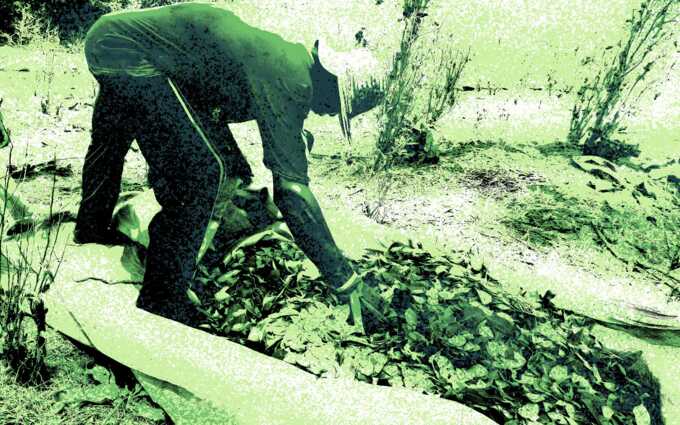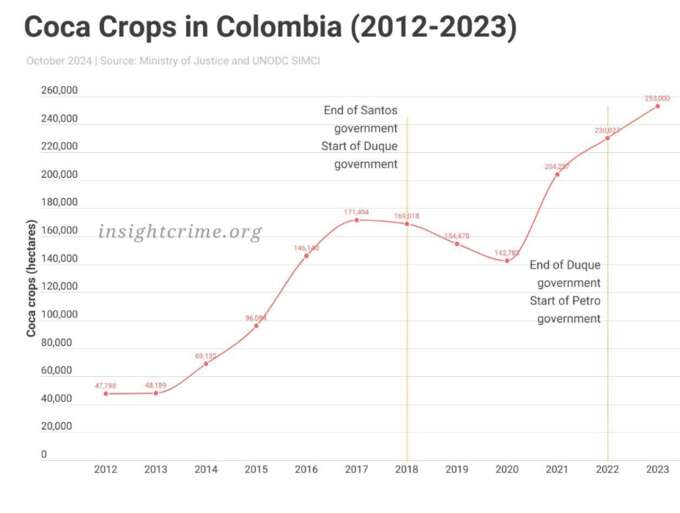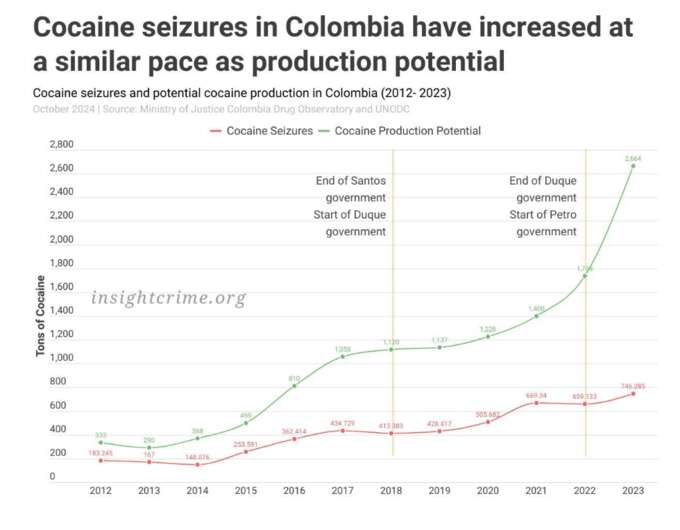Colombia’s coca crops increased, but cocaine production surged, latest figures reveal

Coca crops and cocaine production in Colombia increased during 2023, as the government has stopped forced eradication efforts and concentrated on seizures to fight drug trafficking.
Coca cultivation in the country grew by 10% in the past year, according to the United Nations Office on Drugs and Crime (UNODC) Integrated Illicit Crop Monitoring System (Sistema Integrado de Monitoreo de Cultivos Ilícitos, SIMCI) report for 2023. The country now has 253,000 hectares of coca crops.
Nariño and Cauca continued to be the country’s main coca cultivation hotspots. Nearly 40% of coca production is centered in 14% of the country, according to the report. Nearly half of coca crops are located in special management zones like natural parks (4%), Indigenous reservations (10%), forest reserves (14%), and land titled to Afro-Colombian communities (20%).

During 2022, Colombia saw a record number of coca crops with 230,000 hectares of coca reported, representing a cocaine production potential of 1,738 tons per year. The new numbers keep the upward trend going.
“The report shows that in 2023 potential cocaine production grew by 53%” said Candice Welsch, regional representative for UNODC’s Regional Office for the Andean Region and the Southern Cone. The country now has the potential to produce 2,664 tons of cocaine each year.
The Fruits of a Policy Change?
The government’s anti-narcotic strategy, which breaks away from its predecessors, took a much more permissive stance toward coca cultivation.
Since taking office in 2022, Colombia’s President Gustavo Petro has directed security force and institutional efforts toward drug seizures and attacking the most lucrative links in the drug trade, while helping rural communities move towards legal alternatives. His predecessors were more focused on eradication, which the United States has helped fund for decades.
As part of the policy change, the government stopped forced eradication efforts. Only 20,323 hectares of coca were eradicated in 2023, according to police figures, down from over 100,000 hectares a year under Petro’s predecessor, Iván Duque. But it is unlikely that halting forced eradication efforts is to blame for the increase in cultivation.
Coca crops have become increasingly concentrated in certain areas. This has increased cocaine production capacity, Welsch said, adding that one hectare of coca can now produce twice as much cocaine as it did a decade ago.
“Eradication has also proved itself to be inefficient because manual eradication doesn’t impede replanting,” Ana María Rueda, an investigator from Fundación Ideas para la Paz (FIP), told InSight Crime.
A decline in coca prices created an opportunity for government programs that encouraged coca farmers to trade their illicit crops for legal ones. However, the government’s leniency with coca farmers has not translated into increased support for coca substitution programs. Criminal groups continue to target community leaders advocating for crop substitution. In 2023, armed groups killed at least four such leaders, according to the non-governmental organization Indepaz.
More Cocaine Seized, More Cocaine Produced
While the government has stepped up its efforts to stem the flow of cocaine from Colombia to consumption markets, the report found that the country’s potential cocaine production numbers rose significantly.
In 2023, Colombia seized 739.5 tons of cocaine, a 12.1% increase from the 659 tons seized in 2022. The government is on track to break another record in 2024, with at least 604 tons of cocaine seized in the first nine months of this year. But experts doubt the increased seizures will significantly impact the global drug supply.
“Seizures are going up at the same rate as cocaine [production]” Rueda said.

In 2023, the report put the country’s cocaine production potential at a historic high. Agricultural and technological advancements have allowed farmers to increase the yield of each coca plant. Farmers are increasingly planting new species of coca that need less fertilizer, are plague-resistant, and can be harvested more often. Moreover, coca concentration has made the cultivation, extraction, and production phases of cocaine more efficient.
Additionally, the steep decline in coca prices over the past two years has not led to a significant decrease in coca cultivation, which could mean farmers are stocking up for better times.
And that could be just around the corner. Increasing demand for cocaine in Europe and steady demand in the United States have kept cocaine profitable, meaning criminal groups likely have the cash to pay more for the raw material.
“The drug market for cocaine is expanding not only in traditional markets like North America, Europe, and Oceania, but also in emerging markets such as Asia, Africa, and South America,” said Welsch.
“The more we wage the war on drugs, the higher the risk premium [for traffickers]” said Sanho Tree, Fellow at the Institute for Policy Studies and Director of its Drug Policy Project.
This, coupled with more sophisticated trafficking methods, makes the cocaine pipeline resilient to traditional anti-narcotic efforts in Colombia and the region, and it is likely that unless these factors are addressed the coca situation in Colombia will not radically change in the future.
Read more similar news:
Comments:
comments powered by Disqus

































